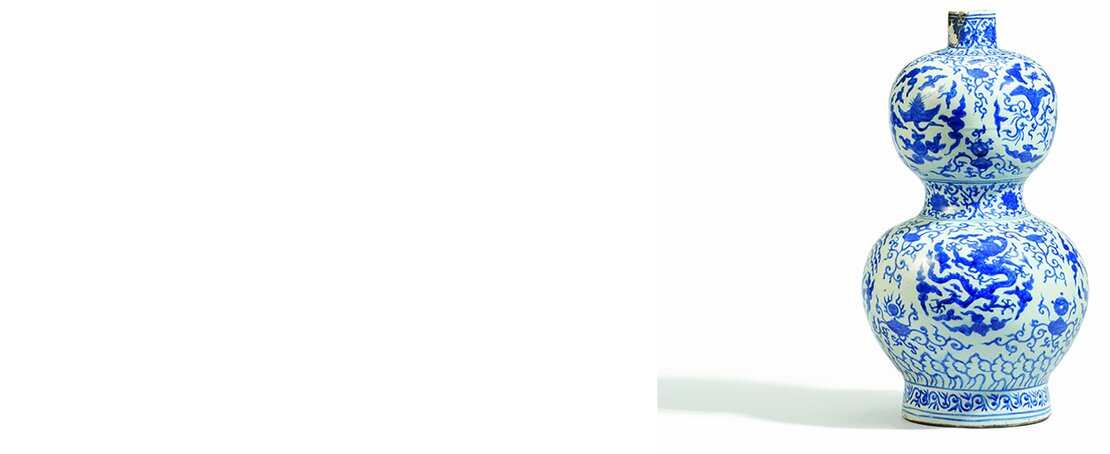For the Elixir of Immortality
From the 960 lots, objects from India, South East Asia and Japan will be offered on the first day, and works of art from China, Tibet and Nepal on the second day. Both days feature a number of monothematic collections such as Kris/Keris from a South German collection and Japanese tea ceramics from a Berlin collection on day one. On the following day, Chinese furniture from Viennese private ownership and Chinese snuff bottles from the Gallery Flachsmann, Kronberg will be auctioned ...

One of the top lots of the auction is a rare blue and white double-gourd vase (huluping) with a Jiajing six-character mark and of the period (1522 - 1566). The form and decoration are characteristic for porcelain production from the reign of the Emperor Jiajing of the Ming dynasty, a follower of Daoism. The porcelains reflected the popularity of Daoism during his reign and his search for immortality. Alongside the dragon and the phoenix as a symbol of power, the vase also depicts auspicious Daoist symbols such as the crane, the ruyi-shaped clouds and lingzhi, the mushroom of immortality. Forming the rebus for “blessing” (fu) and “wealth” (lu) which one acquires from an official position, the shape of the gourd itself reflects the desire for immortality. The double-gourd is also associated with one of the Eight Immortals, Li Tieguai, as the receptacle in which he kept his elixir of immortality and a special medicine for the sick (lot 761, 40/80,000).
Another highlight of the auction was made in today’s Yunnan Province, once the realm of the Dali kingdom (12th century). With an estimate of 100/150,000, the bronze Buddha Amitaba was acquired in the Himalayas in the 1920s. The Dali Kingdom centered in the area of today's Yunnan Province between the 7th and 13th centuries. Buddhism in the early 9th century replaced the indigenous shamanistic cult resulting in a religious boom, after Buddhism had lost its predominant position in the Chinese mainland (lot 595).
One rhinoceros horn cup stands out in particular: from the Ming dynasty, the detailed carving shows scholars and a deer in a landscape with pines and other trees (lot 710, 60/80,000).
A large limestone head of Guanyin, also from the Ming dynasty, is estimated at 20/30,000 (lot 596), whilst a very beautiful and decorative 19th century imperial winter dragon robe (chaofu) is valued at 20/25,000 (lot 719). From the large group of furniture offered, one lot in particular is worth mentioning: a pair of Qing dynasty scholar’s chairs (guanmaoyi) made of huali wood (lot 728, 30/50,000).
SOUTH EAST ASIA
A very large bronze Buddha in maravijava in Sukhothai style stands out amongst the South East Asian objects offered for auction (lot 71, 40/50,000). A large Buddha head, also in bronze, from the 14th/15th century is estimated at 30/35,000 (lot 68).
JAPAN
One of the top Japanese lots is an unusual work by Morita Shiryû from 1964, an artist for whom Lempertz has already successfully auctioned a number of works. The work features the characters “chû” (rise high in the sky) in thick, deep black ink on rough paper (lot 271, 20/25,000).
Further highlights include an imposing figure of the enthroned Monju Basatsu at over 1.7 m high, from the 18th/early 19th century (lot 278, 20/30,000) and a pair of octagonal kakiemon dishes from around 1700 decorated with phoenix and with the provenance of the Margraves and Grand Dukes of Baden, Baden-Baden. Kakiemon dishes such as these, large and small, as well as jugs and cups, would have been displayed symmetrically on small consoles in a wooden trellis, which dressed the wall, often flanking a mirror or fireplace. The great royal residencies in Munich, Dresden and Berlin all possessed such porcelain rooms, which were copied by the small courts (lot 321, 20/30,000). A large Raku dish from Kyoto of the Edo period is signed Kenzan. From the Vollmer-Bergmann collection, it has an estimate of 20/30,000 (lot 337). Amongst the large selection of wood cut prints, an album with 55 sheets by Utagawa Hiroshige leads the way (lot 161, 8/12,000).
